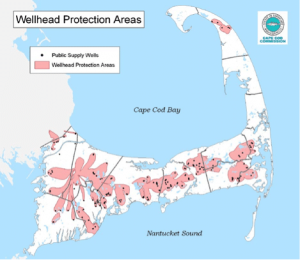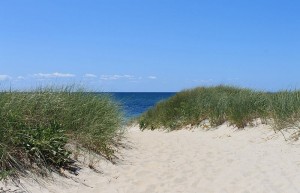 Located on Cape Cod in Massachusetts, the Sagamore Lens is the largest of six groundwater lenses included in the Cape Cod Sole Source Aquifer, and is the public drinking water supply for the towns of Barnstable, Bourne, Falmouth, Mashpee, Sandwich, Yarmouth, and the Massachusetts Military Reserve (MMR). It provides water for extensive agricultural operations including 236 square miles of cranberry bogs, croplands, nurseries, pastures, and orchards. The Sagamore Lens is mapped as a Priority Habitat by the Natural Heritage and Endangered Species Program (NHESP) of the Massachusetts Division of Fisheries and Wildlife, and it provides the water for 153 vernal pools, 180 fresh water ponds, 20 streams and rivers, and 250 miles of coastal shoreline. It also supports a vibrant seasonal tourist population that brings millions of dollars into the Commonwealth. Unfortunately, the Sagamore Lens is experiencing increases in demand and contamination that need to be addressed.
Located on Cape Cod in Massachusetts, the Sagamore Lens is the largest of six groundwater lenses included in the Cape Cod Sole Source Aquifer, and is the public drinking water supply for the towns of Barnstable, Bourne, Falmouth, Mashpee, Sandwich, Yarmouth, and the Massachusetts Military Reserve (MMR). It provides water for extensive agricultural operations including 236 square miles of cranberry bogs, croplands, nurseries, pastures, and orchards. The Sagamore Lens is mapped as a Priority Habitat by the Natural Heritage and Endangered Species Program (NHESP) of the Massachusetts Division of Fisheries and Wildlife, and it provides the water for 153 vernal pools, 180 fresh water ponds, 20 streams and rivers, and 250 miles of coastal shoreline. It also supports a vibrant seasonal tourist population that brings millions of dollars into the Commonwealth. Unfortunately, the Sagamore Lens is experiencing increases in demand and contamination that need to be addressed.
Cape Cod was formed during the last continental deglaciation that occurred between 15,000 and 20,000 years ago, and the glacial deposits tend to contain medium to coarse sand with finer sands at depth. These immensely permeable surface sands make for a very high yielding groundwater system – and also make the Cape Cod Aquifer extremely susceptible to contamination. Public and private wastewater systems, the MMR, and emerging contaminants such as pharmaceuticals and personal care products have all contributed to the recent increased degradation of the Sagamore Lens. Fortunately, Cape Cod government and residents are acutely in tune with their natural resources and have taken steps to ensure the future health of the Cape’s Sole Source Aquifer.
 Over 30 years ago, policy makers and water planners worked vigorously to implement mechanisms to protect Cape Cod’s drinking water supply. One key implementation was the adoption of Wellhead Protection Areas to protect the lands that recharge wells. In addition, residents enthusiastically approved municipal acquisition of land for protection of wellhead areas, and cleanup of the significant MMR contamination began around this time.
Over 30 years ago, policy makers and water planners worked vigorously to implement mechanisms to protect Cape Cod’s drinking water supply. One key implementation was the adoption of Wellhead Protection Areas to protect the lands that recharge wells. In addition, residents enthusiastically approved municipal acquisition of land for protection of wellhead areas, and cleanup of the significant MMR contamination began around this time.
Today, Tata & Howard is working with the Upper Cape Regional Water Supply Cooperative on an assessment of the sustainability of the Sagamore Lens. Sustainability requires that the aquifer not be completely used up or destroyed, and that it is protected and kept clean and plentiful for future generations. Unfortunately, the Cape Cod Aquifer has been recently compromised by contaminants of emerging concern (CECs), such as personal care products and pharmaceuticals, which have entered the aquifer through wastewater discharge. Tata & Howard’s study addresses the sustainability of the aquifer through 2030, taking into account different scenarios including drought conditions, wastewater injection, and increased demand.
 The study proposes utilizing a regional approach to manage withdrawals, construct adequate water supplies, monitor areas at risk as withdrawals increase, and to incorporate a Drought Management Plan. In addition, the study identifies preferred water supply areas as well as sources and areas at risk, and it proposes a management plan for wastewater disposal and MMR plumes, again using a regional approach.
The study proposes utilizing a regional approach to manage withdrawals, construct adequate water supplies, monitor areas at risk as withdrawals increase, and to incorporate a Drought Management Plan. In addition, the study identifies preferred water supply areas as well as sources and areas at risk, and it proposes a management plan for wastewater disposal and MMR plumes, again using a regional approach.
For decades, Cape Cod government and residents have been progressive in their efforts to protect the area’s drinking water supply, and have taken steps to ensure that future generations are able to enjoy and inhabit this naturally beautiful and ecologically rich area of the country. Through careful research, planning, and cooperative implementation, Cape Cod will remain a healthy seaside mecca for years to come.
